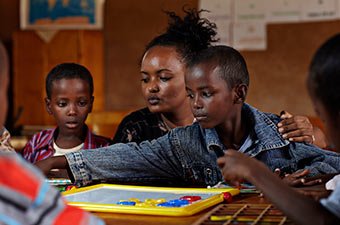Session 10/15
Page 4/7: Topic B: Giving the child a secure personal spaceTopic B: Giving the child a secure personal space


How can you gradually help the child or young person placed in care to feel that they have a personal space, and feel that they belong in the family?
Each child should have its own personal space: Involve the child in decorating its own room or space. The child can have its own chair at the dinner table. Perhaps it can have a personal locked box or a closet that only the child can open.
The child should also have its personal time space: the right to relax in his or her own room or place. For children with emotional or behavioural problems, even simple activities – like a few hours in school – can be extremely exhausting. Many problems can be prevented if the child knows that ”now I have an hour for myself to relax, play, or do my homework”. Planning regular intervals of private time can be very helpful. Children with a poor sense of time tend to stay too brief or too long in their room. Therefore, agreeing on a routine for short pauses can prevent exhaustion and temper tantrums.
For infants and toddlers: The personal space can also be a thing like a teddy bear, a doll, a special T-shirt, etc. Discuss an agreement at home: how can other family members show that they respect the child’s ownership of the object? Having a personal pet – like a dog, a cat or a bird – can promote attachment. Many children start the attachment process by bonding with an animal. This is less complicated than becoming attached to a person.
To support the baby/toddler’s growing awareness of itself: Playing with mirrors, or letting the child hear its own voice from a cell phone or tape recorder can support the awareness of ”Hey, this is me”!
One foster parent can record interactions between the child and caregiver with a cell phone, or record the child’s play with other children. Talking about this afterwards while watching the video is a great way of helping the child become aware of how its actions affect others, and how to listen, think and respond. This helps the child understand how to behave in interactions. Knowing how ones behaviour affects others is something many deprived children have problems with because they received little guidance early in life.
When you give the child feedback you should only talk about the best and most positive interactions. Don’t point out any inappropriate responses. Focus on the positive actions.
Activities for older children and teenagers: At a set time every day (bedtime is good), have small dialogues with the child or young person about what happened during the day (or whatever interests the child). Discuss and agree with the child how to write this in a personal notebook. Gradually, let the child write a small summary. If the child has reading problems, the summary can be recorded on yours or the child’s cell phone. This is a good activity to get to terms with all the things that happened during the day, and it can teach the child to reflect calmly upon what it thinks and feels. Besides, this activity improves memory and foresight.
Occasionally, you can take pictures of the child’s activities and place them in the notebook. Any information about the child’s relatives should also be discussed with the child and noted.
Make it a routine to take a picture every week or month of the child and talk about the physical changes and developments as the child grows. Use a tape measure to mark the child’s growth regularly and set a mark on for example the kitchen wall. This activity also enhances the child’s awareness of itself (”Wow! You have grown the quarter of an inch – in only six months! How does it feel to be so big?”).
Talking about what is characteristic in the child’s behaviour and what makes it special and different from other children is useful. Also, what is characteristic in the way it interacts with others (”you always pay attention when you talk to me, and you look me in the eyes – that makes me happy!”).
Caregiver filming a child’s activity
CHECKLIST FOR UNDERSTANDING
10 minutes
- How did these suggestions inspire you? What can you do at home?
- Do you have good practices, traditions or ideas for promoting the child’s sense of having a personal space and feel at home?
- How can you help the child become more aware of itself, and understand how it interacts with other members in the family?
- What activities do you think will help your child become more aware of itself? For example: write in a diary each day, record video or monologues on your cell phone, playing with mirrors, or other activities.
